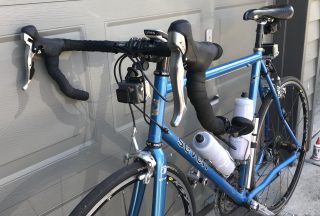“When he slowed the video down, Hank was shocked to see that the vehicle’s passenger held a knife in his outstretched hand.”
This post by lawyers Chris Thomas and Ray Thomas is part of a paid promotional partnership with Thomas, Coon, Newton & Frost.
Sometimes video evidence is essential to holding dangerous road users accountable. The case of our client Hank Bosak illustrates this well.
Installing the camera system on his bike in 2017 helped ease the anxiety he felt when riding.
On June 22, 2019, Hank Bosak, a 60-year-old mechanical engineer, prepared to go for a Saturday afternoon bike ride in rural Washington County. As was his custom for the past few years, he turned on the front and rear video cameras he had installed on his bike.
In 2004, Hank was hit on a rural, Washington County road by a driver who fled the scene, leaving him with multiple fractures on the side of the road. The sudden nature of that collision, and Hank’s injuries, prevented him from obtaining the license plate or other information to identify the hit and run vehicle. Since that time, Hank has felt anxious about riding on the beautiful, low traffic rural roads near his home, and often felt a sense of impending danger from the sound of overtaking traffic.
Installing the camera system on his bike in 2017 helped ease the anxiety he felt when riding.
As Hank pedaled along Hornecker Road on that June afternoon by himself, at about mile 3 of a 30 mile ride, he was passed at high speed and at a distance significantly below the “fallover distance” required under Oregon law (ORS 811.065).
Here is how the pass appeared in real time to Hank’s rear-facing camera:
And here is the real time pass from Hank’s forward-facing camera:
Thankfully, Hank’s rear-view mirror allowed him to view the car as it approached and prepare for the close pass. Shaken, but uninjured, Hank finished his ride without incident, wondering why the car had passed him so closely, particularly in the absence of any oncoming traffic. When he arrived at home, he decided to revisit the incident and planned to report the illegal pass to police. When he slowed the video down, Hank was shocked to see that, not only had he been passed dangerously closely, but the vehicle’s passenger held a knife in his outstretched hand, shown here:

(Photos: Thomas, Coon, Newton & Frost)

Thanks to the information captured on Hank’s camera system, including the vehicle’s license plate, the story attracted the attention of local media and law enforcement, ultimately resulting in criminal conviction of the passenger for Felony Unlawful Use of a Weapon and Misdemeanor Recklessly Endangering Another Person.
Hank’s diligent use of cameras allowed him to capture both the dangerously close pass and the extraordinary criminal activity of the vehicle occupants. As an engineer, Hank has a helpful technical background that allowed him to set up and maintain his camera system. Below, we share the details of Hank’s system, which may provide folks curious about riding with cameras with a useful guide on how to do it. Perhaps if enough bicyclists use cameras, and use them to hold dangerous road users accountable, a deterrent effect will develop on the roadway similar to red light and speed cameras, premises security cameras, and other surveillance tools.
Hank’s Camera System
Hank’s system consists of two GoPro cameras. His are the Hero 4 model, which can be found online for about $100 each. The current model, the Hero 7, runs about $200. Other, less expensive options are available, and Hank found that resolution of at least 1080 pixels is needed to make out a license plate number on a speeding vehicle. GoPro or generic mounts for the front handlebars and seat post or frame seat stay cost about $30 each.
Hank used SD memory cards in each camera with 32 GB of storage, which cost less than $10 each and record about two hours of riding. Hank also outfitted each camera with a supplemental battery, made by BacPac for about $50 each, to provide enough recording time for his customary two hour ride. While lower resolution cameras use less energy, Hank has found that the sharp image his cameras provide warrant the additional energy use.
A comparable camera, including the extended battery and case, is shown here:


In total, one of Hank’s units costs between $190 and $290.
After each ride, Hank plugs in his batteries to the charger, and, if nothing eventful occurred on the ride, he pushes a button on each camera that deletes its memory card.
For those who lack Hank’s technical background, once the above components are obtained, a local bike shop should be able to help assemble and install them (Olson’s Bicycles in Forest Grove charges about $40 in labor).
Although it carries significant up-front cost, your system only needs to work once to make it all worthwhile.
As lawyers, video evidence can provide strong, irrefutable evidence supporting our clients’ claims for damages resulting from dangerous behavior by road users. While we wish taking such measures was not necessary, we hope this article helps you find peace of mind whether you ever need the footage or not.
— by Ray Thomas and Chris Thomas
— Get our headlines delivered to your inbox.
— Support this independent community media outlet with a one-time contribution or monthly subscription.

